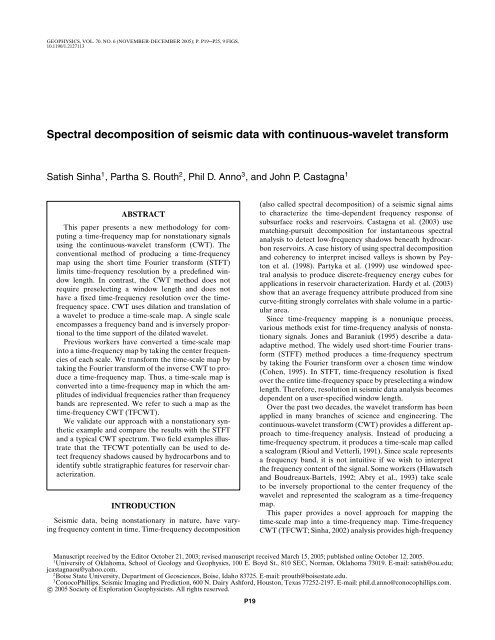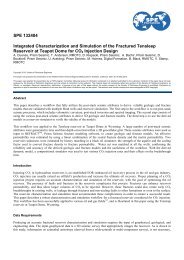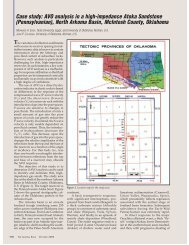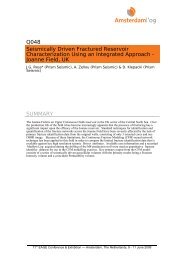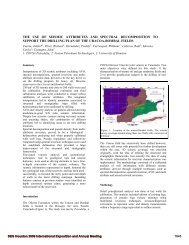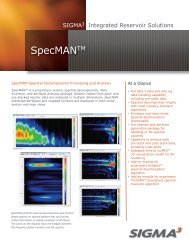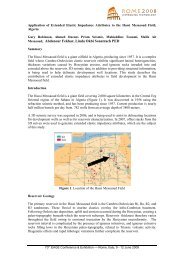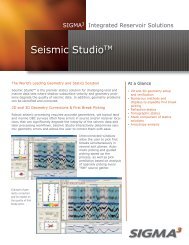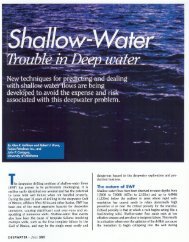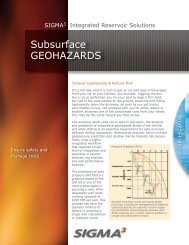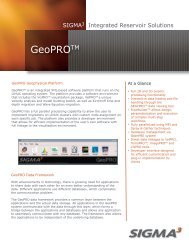Spectral decomposition of seismic data with ... - Sigmacubed.com
Spectral decomposition of seismic data with ... - Sigmacubed.com
Spectral decomposition of seismic data with ... - Sigmacubed.com
Create successful ePaper yourself
Turn your PDF publications into a flip-book with our unique Google optimized e-Paper software.
GEOPHYSICS, VOL. 70, NO. 6 (NOVEMBER-DECEMBER 2005); P. P19–P25,9FIGS.<br />
10.1190/1.2127113<br />
<strong>Spectral</strong> <strong>de<strong>com</strong>position</strong> <strong>of</strong> <strong>seismic</strong> <strong>data</strong> <strong>with</strong> continuous-wavelet transform<br />
Satish Sinha 1 , Partha S. Routh 2 , Phil D. Anno 3 , and John P. Castagna 1<br />
ABSTRACT<br />
This paper presents a new methodology for <strong>com</strong>puting<br />
a time-frequency map for nonstationary signals<br />
using the continuous-wavelet transform (CWT). The<br />
conventional method <strong>of</strong> producing a time-frequency<br />
map using the short time Fourier transform (STFT)<br />
limits time-frequency resolution by a predefined window<br />
length. In contrast, the CWT method does not<br />
require preselecting a window length and does not<br />
have a fixed time-frequency resolution over the timefrequency<br />
space. CWT uses dilation and translation <strong>of</strong><br />
a wavelet to produce a time-scale map. A single scale<br />
en<strong>com</strong>passes a frequency band and is inversely proportional<br />
to the time support <strong>of</strong> the dilated wavelet.<br />
Previous workers have converted a time-scale map<br />
into a time-frequency map by taking the center frequencies<br />
<strong>of</strong> each scale. We transform the time-scale map by<br />
taking the Fourier transform <strong>of</strong> the inverse CWT to produce<br />
a time-frequency map. Thus, a time-scale map is<br />
converted into a time-frequency map in which the amplitudes<br />
<strong>of</strong> individual frequencies rather than frequency<br />
bands are represented. We refer to such a map as the<br />
time-frequency CWT (TFCWT).<br />
We validate our approach <strong>with</strong> a nonstationary synthetic<br />
example and <strong>com</strong>pare the results <strong>with</strong> the STFT<br />
and a typical CWT spectrum. Two field examples illustrate<br />
that the TFCWT potentially can be used to detect<br />
frequency shadows caused by hydrocarbons and to<br />
identify subtle stratigraphic features for reservoir characterization.<br />
INTRODUCTION<br />
Seismic <strong>data</strong>, being nonstationary in nature, have varying<br />
frequency content in time. Time-frequency <strong>de<strong>com</strong>position</strong><br />
(also called spectral <strong>de<strong>com</strong>position</strong>) <strong>of</strong> a <strong>seismic</strong> signal aims<br />
to characterize the time-dependent frequency response <strong>of</strong><br />
subsurface rocks and reservoirs. Castagna et al. (2003) use<br />
matching-pursuit <strong>de<strong>com</strong>position</strong> for instantaneous spectral<br />
analysis to detect low-frequency shadows beneath hydrocarbon<br />
reservoirs. A case history <strong>of</strong> using spectral <strong>de<strong>com</strong>position</strong><br />
and coherency to interpret incised valleys is shown by Peyton<br />
et al. (1998). Partyka et al. (1999) use windowed spectral<br />
analysis to produce discrete-frequency energy cubes for<br />
applications in reservoir characterization. Hardy et al. (2003)<br />
show that an average frequency attribute produced from sine<br />
curve-fitting strongly correlates <strong>with</strong> shale volume in a particular<br />
area.<br />
Since time-frequency mapping is a nonunique process,<br />
various methods exist for time-frequency analysis <strong>of</strong> nonstationary<br />
signals. Jones and Baraniuk (1995) describe a <strong>data</strong>adaptive<br />
method. The widely used short-time Fourier transform<br />
(STFT) method produces a time-frequency spectrum<br />
by taking the Fourier transform over a chosen time window<br />
(Cohen, 1995). In STFT, time-frequency resolution is fixed<br />
over the entire time-frequency space by preselecting a window<br />
length. Therefore, resolution in <strong>seismic</strong> <strong>data</strong> analysis be<strong>com</strong>es<br />
dependent on a user-specified window length.<br />
Over the past two decades, the wavelet transform has been<br />
applied in many branches <strong>of</strong> science and engineering. The<br />
continuous-wavelet transform (CWT) provides a different approach<br />
to time-frequency analysis. Instead <strong>of</strong> producing a<br />
time-frequency spectrum, it produces a time-scale map called<br />
a scalogram (Rioul and Vetterli, 1991). Since scale represents<br />
a frequency band, it is not intuitive if we wish to interpret<br />
the frequency content <strong>of</strong> the signal. Some workers (Hlawatsch<br />
and Boudreaux-Bartels, 1992; Abry et al., 1993) take scale<br />
to be inversely proportional to the center frequency <strong>of</strong> the<br />
wavelet and represented the scalogram as a time-frequency<br />
map.<br />
This paper provides a novel approach for mapping the<br />
time-scale map into a time-frequency map. Time-frequency<br />
CWT (TFCWT; Sinha, 2002) analysis provides high-frequency<br />
Manuscript received by the Editor October 21, 2003; revised manuscript received March 15, 2005; published online October 12, 2005.<br />
1<br />
University <strong>of</strong> Oklahoma, School <strong>of</strong> Geology and Geophysics, 100 E. Boyd St., 810 SEC, Norman, Oklahoma 73019. E-mail: satish@ou.edu;<br />
jcastagnaou@yahoo.<strong>com</strong>.<br />
2<br />
Boise State University, Department <strong>of</strong> Geosciences, Boise, Idaho 83725. E-mail: prouth@boisestate.edu.<br />
3<br />
ConocoPhillips, Seismic Imaging and Prediction, 600 N. Dairy Ashford, Houston, Texas 77252-2197. E-mail: phil.d.anno@conocophillips.<strong>com</strong>.<br />
c○ 2005 Society <strong>of</strong> Exploration Geophysicists. All rights reserved.<br />
P19
P20<br />
Sinha et al.<br />
resolution at low frequencies and high time resolution at high<br />
frequencies. This optimal time-frequency resolution property<br />
<strong>of</strong> the TFCWT makes it useful in <strong>seismic</strong> <strong>data</strong> analysis.<br />
Computing the TFCWT in the Fourier domain is a fast process.<br />
Furthermore, TFCWT is an invertible process such that<br />
the inverse Fourier transform <strong>of</strong> the time summation <strong>of</strong> the<br />
TFCWT reconstructs the original signal, provided the inverse<br />
wavelet transform exists. For our purposes we require only the<br />
forward transform; reproducibility is not a strict requirement.<br />
Seismic <strong>data</strong> analysts sometimes observe low-frequency<br />
shadows in association <strong>with</strong> hydrocarbon reservoirs. The<br />
shadow is probably caused by attenuation <strong>of</strong> high-frequency<br />
energy in the reservoir itself (Dilay and Eastwood, 1995;<br />
Mitchell et al., 1997), such that the local dominant frequency<br />
Figure 1. A chirp signal consisting <strong>of</strong> two known hyperbolic sweep frequencies <strong>with</strong><br />
constant amplitude for each frequency.<br />
moves toward the low-frequency range. Thus, anomalous lowfrequency<br />
energy is concentrated at or beneath the reservoir<br />
level. The low frequencies are probably not caused by<br />
inelastic attenuation. Ebrom (2004) lists about ten possible<br />
mechanisms. High-frequency resolution at low frequencies,<br />
given by the TFCWT, helps detect these shadows. On the<br />
other hand, high time resolution at high frequencies can enhance<br />
stratigraphic features from <strong>seismic</strong> <strong>data</strong>. Marfurt and<br />
Kirlin (2001) investigate how tuning frequency varies <strong>with</strong><br />
thickness and use spectrally de<strong>com</strong>posed <strong>data</strong> to resolve thin<br />
beds.<br />
In this paper, we derive a formula to convert a scalogram<br />
to a TFCWT. We begin by <strong>com</strong>paring the TFCWT spectrum<br />
for a hyperbolic chirp signal <strong>with</strong> the CWT spectrum and the<br />
STFT. Then we calculate TFCWT spectra<br />
for two real <strong>data</strong> sets, one from Nigeria<br />
and another publicly available from the<br />
Stratton field, south Texas. In the first example,<br />
we show that single-frequency visualization<br />
<strong>of</strong> a <strong>seismic</strong> section in the frequency<br />
domain <strong>with</strong> the TFCWT reveals<br />
low-frequency anomalies associated <strong>with</strong><br />
hydrocarbon reservoirs. In the second example,<br />
we show that single-frequency slices<br />
along a horizon can be used to enhance<br />
stratigraphic features.<br />
TIME-FREQUENCY MAP FROM STFT<br />
The Fourier transform f ˆ(ω) <strong>of</strong> a signal f (t) is the inner<br />
product <strong>of</strong> the signal <strong>with</strong> the basis function e iωt , i.e.,<br />
∫ ∞<br />
f ˆ(ω) =〈f (t),e iωt 〉= f (t)e −iωt dt, (1)<br />
−∞<br />
where t is time. A <strong>seismic</strong> signal, when transformed into the<br />
frequency domain using the Fourier transform, gives the overall<br />
frequency behavior; such a transformation is inadequate<br />
for analyzing a nonstationary signal. We can include the time<br />
dependence by windowing the signal (i.e., taking short segments<br />
<strong>of</strong> the signal) and then performing the Fourier transform<br />
on the windowed <strong>data</strong> to obtain local frequency information.<br />
Such an approach <strong>of</strong> time-frequency analysis is called the<br />
short-time Fourier transform (STFT), and the time-frequency<br />
map is called a spectrogram (Cohen, 1995). The STFT is given<br />
by the inner product <strong>of</strong> the signal f (t) <strong>with</strong> a time-shifted window<br />
function φ(t). Mathematically, it can be expressed as<br />
Figure 2. A spectrogram <strong>of</strong> the chirp signal using a 400-ms<br />
window length. Notice that the lower frequencies are well resolved<br />
but the higher frequencies are not resolved.<br />
ST FT (ω,τ) =〈f (t),φ(t − τ)e iωt 〉<br />
=<br />
∫ ∞<br />
f (t) ¯φ(t − τ)e −iωt dt, (2)<br />
−∞<br />
where the window function φ is centered at time t = τ, <strong>with</strong> τ<br />
being the translation parameter, and ¯φ is the <strong>com</strong>plex conjugate<br />
<strong>of</strong> φ.<br />
We show a spectrogram <strong>com</strong>puted for a chirp signal (Figure<br />
1) <strong>with</strong> two hyperbolic frequency sweeps in Figure 2. We<br />
use a 400-ms-long Hanning window for this <strong>com</strong>putation. Note<br />
in the spectrogram that the low frequencies are well resolved<br />
and the high frequencies are either poorly resolved or not visible<br />
at all. The reason is because the frequency resolution is
Time-Frequency De<strong>com</strong>position<br />
P21<br />
fixed by the preselected window length and is recognized as<br />
the fundamental problem <strong>of</strong> the STFT in spectral analysis <strong>of</strong> a<br />
nonstationary signal.<br />
TIME-FREQUENCY MAP FROM CWT (TFCWT)<br />
The CWT is an alternative method to analyze a signal. In<br />
the CWT, wavelets dilate in such a way that the time support<br />
changes for different frequencies. Smaller time support<br />
increases the frequency support, which shifts toward higher<br />
frequencies. Similarly, larger time support decreases the frequency<br />
support, which shifts toward lower frequencies. Thus,<br />
when the time resolution increases, the frequency resolution<br />
decreases, and vice versa (Mallat, 1999).<br />
A wavelet is defined as a function ψ(t) ∈ L 2 (R) <strong>with</strong>azero<br />
mean, localized in both time and frequency. By dilating and<br />
translating this wavelet ψ(t), we produce a family <strong>of</strong> wavelets:<br />
ψ σ,τ (t) = 1 √ σ<br />
ψ<br />
( t − τ<br />
σ<br />
)<br />
, (3)<br />
where σ, τ ∈Rand σ is not zero and σ is the dilation parameter<br />
or scale. Note that the wavelet is normalized such that the L2-<br />
norm ‖ψ‖ is equal to unity. The CWT is defined as the inner<br />
product <strong>of</strong> the family <strong>of</strong> wavelets ψ σ,τ (t)<strong>with</strong> the signalf (t).<br />
This is given by<br />
∫ ∞<br />
F W (σ, τ) =〈f (t),ψ σ,τ (t)〉= f (t) 1 ( t − τ<br />
√ ¯ψ<br />
−∞ σ σ<br />
(4)<br />
where ¯ψ is the <strong>com</strong>plex conjugate <strong>of</strong> ψ and F W (σ, τ) isthe<br />
time-scale map (i.e., the scalogram). The convolution integral<br />
in equation 4 can be <strong>com</strong>puted easily in the Fourier domain.<br />
The choice for the scale and the translation parameter can be<br />
arbitrary, and we can choose to represent it any way we like.<br />
To reconstruct the function f (t) from the wavelet transform,<br />
we use Calderon’s identity (Daubechies, 1992), given by<br />
f (t) = 1 ∫ ∞ ∫ ∞<br />
( ) t − τ dσ dτ<br />
F W (σ, τ)ψ<br />
√ .<br />
C ψ −∞ −∞<br />
σ σ 2 (5) σ<br />
For the inverse transform to exist, we require that the analyzing<br />
wavelet satisfy the admissibility condition, given by<br />
∫ ∞<br />
| ˆψ(ω)| 2<br />
C ψ = 2π<br />
dω < ∞, (6)<br />
−∞ ω<br />
)<br />
dt,<br />
time-scale map, in terms <strong>of</strong> a time-frequency map, a number<br />
<strong>of</strong> approaches can be taken. The easiest step would be<br />
to stretch the scale to an equivalent frequency, depending<br />
on the scale-frequency mapping <strong>of</strong> the wavelet. Typically for<br />
time-frequency analysis, one converts a scalogram to a timefrequency<br />
spectrum using f c /f ,where,f c is the center frequency<br />
<strong>of</strong> the wavelet (Hlawatsch and Bartels, 1992). Such<br />
a typical CWT spectrum <strong>of</strong> the chirp signal using the Morlet<br />
wavelet is shown in Figure 3. However, we take an alternative<br />
approach and <strong>com</strong>pute a frequency spectrum <strong>of</strong> the signal<br />
using the wavelet as an adaptive window. Because <strong>of</strong> the Morlet<br />
wavelet’s dilation property, it is a natural window for signals<br />
that require high-frequency resolution at low frequencies<br />
and high time resolution at high frequencies. The translation<br />
property allows us to examine the frequency content at various<br />
times, thus leading to a time-frequency map that is adaptive<br />
to the nonstationary nature <strong>of</strong> <strong>seismic</strong> signals. This timefrequency<br />
map is obtained by taking the Fourier transform <strong>of</strong><br />
the inverse continuous wavelet transform.<br />
Replacing f (t) from equation 5 into equation 1 gives<br />
∫ ∞ ∫ ∞<br />
1<br />
−∞ −∞ σ 2√ σ<br />
( t − τ<br />
× F W (σ, τ)ψ<br />
σ<br />
f ˆ(ω) = 1 ∫ ∞<br />
C ψ −∞<br />
)<br />
e −iωt dσ dτ dt. (8)<br />
where ˆψ(ω) is the Fourier transform <strong>of</strong> ψ(t) andwhereC ψ<br />
is a constant for wavelet ψ. The integrand in equation 6<br />
has an integrable discontinuity at ω = 0 and also implies<br />
that ∫ ψ(t)dt = 0. A <strong>com</strong>monly used wavelet in continuouswavelet<br />
transform is the Morlet wavelet, defined as (Torrence<br />
and Compo, 1998)<br />
ψ 0 (t) = π −1/4 e iω 0t e −t2 /2 , (7)<br />
where ω 0 is the frequency and is taken as 2π to satisfy the<br />
admissibility condition. The center frequency <strong>of</strong> the Morlet<br />
wavelet being inversely proportional to the scale provides an<br />
easy interpretation from scale to frequency.<br />
We note that a scale represents a frequency band and not<br />
a single frequency. The scalogram does not provide a direct<br />
intuitive interpretation <strong>of</strong> frequency. To interpret the<br />
Figure 3. A typical CWT spectrum obtained for the chirp signal<br />
shown in Figure 1. It is converted from the scalogram, described<br />
by equation (4), using the center frequencies <strong>of</strong> scales.
P22<br />
Sinha et al.<br />
Using the scaling and shifting theorem <strong>of</strong> the Fourier transform,<br />
we get<br />
∫ ∞<br />
( ) t − τ<br />
ψ e −iωt dt = σe −iωτ ˆψ (σω) . (9)<br />
−∞ σ<br />
By interchanging the integrals and substituting equation 9 into<br />
equation 8, we obtain<br />
f ˆ(ω) = 1 ∫ ∞<br />
C ψ −∞<br />
∫ ∞<br />
−∞<br />
1<br />
σ 2√ σ F W (σ, τ)σ ˆψ(σω)e −iωτ dσ dτ,<br />
(10)<br />
where ˆψ(ω)is the Fourier transform <strong>of</strong> the mother wavelet.<br />
To obtain a time-frequency map, we remove the integration<br />
over the translation parameter τ and replace f ˆ(ω)byf ˆ(ω,τ).<br />
This is given by<br />
f ˆ(ω,τ) = 1 ∫ ∞<br />
−iωτ<br />
dσ<br />
F W (σ, τ) ˆψ(σω)e . (11)<br />
C ψ −∞<br />
σ<br />
3/2<br />
Equation 11 is the fundamental equation that allows us to<br />
<strong>com</strong>pute TFCWT. This can also be represented as the inner<br />
product between the wavelet transform <strong>of</strong> the signal F W (σ, τ)<br />
and a scaled and modulated window given by ˆψ ω (σ ), where<br />
the scaling is over the frequency. For a particular frequency,<br />
we have an appropriately scaled window. The integration in<br />
the inner product space is over all scales, as denoted by equation<br />
11. This can be represented by<br />
ˆ f (ω,τ) = 〈 F W (σ, τ), ˆψ ω (σ ) 〉 , (12)<br />
the STFT spectrum (Figure 2). In the CWT spectrum, the energies<br />
in both frequency trends erroneously decrease <strong>with</strong> increasing<br />
frequency. Considering the fact that the typical CWT<br />
spectrum is <strong>com</strong>puted in terms <strong>of</strong> frequency bands (i.e., scales)<br />
and is represented by taking the center frequency <strong>of</strong> the frequency<br />
bands, these frequency bands overlap each other and<br />
the overlap increases <strong>with</strong> increasing frequency. This results in<br />
an apparent loss <strong>of</strong> energy in the CWT spectrum that can be<br />
confused <strong>with</strong> attenuation effects which are not present in the<br />
signal. However, the TFCWT spectrum (Figure 4) does not<br />
show any erroneous attenuation. The blurring effect on each<br />
end is because the TFCWT has high-frequency resolution and<br />
low-time resolution at low frequencies and low-frequency resolution<br />
and high time resolution at high frequencies. Thus, the<br />
TFCWT improves resolution for a nonstationary signal. In addition<br />
to the improvement in the time-frequency resolution,<br />
the new methodology inheriting the CWT avoids the subjective<br />
choice <strong>of</strong> window length necessary for the STFT.<br />
APPLICATIONS OF TFCWT TO FIELD DATA<br />
Time-frequency spectra produced from the TFCWT can be<br />
used to interpret <strong>seismic</strong> <strong>data</strong> in the frequency domain. We<br />
have conducted such analyses <strong>with</strong> poststack <strong>data</strong> sets. Adding<br />
a frequency axis to a 2D <strong>seismic</strong> section makes the <strong>data</strong><br />
where the scaled and modulated window is given by<br />
−iωτ ˆψ(σω)e ¯ˆψ ω (σ ) = .<br />
C ψ σ 3/2 (13)<br />
Here,<br />
¯ˆψ ω (σ ) is the <strong>com</strong>plex conjugate <strong>of</strong> ˆψ ω (σ ).<br />
Equation 12 shows that the effective window is the scaled<br />
and modulated wavelet that acts on the transformed signal in<br />
the wavelet domain. In contrast, the chosen window in the<br />
STFT directly operates on the time-domain signal given in<br />
equation 2, and the inner product space is integrated over all<br />
times. The time-frequency map generated by equation 11 or<br />
equation 12 from the scalogram F W (σ, τ) is not obtained by<br />
the direct transformation <strong>of</strong> a scale to its center frequency;<br />
rather, this map provides energy at the desired frequency and<br />
avoids the <strong>com</strong>plication <strong>of</strong> overlapping frequency bands <strong>com</strong>mon<br />
to a scale-frequency transformation. Equation 11 can be<br />
<strong>com</strong>puted using a two-step procedure. First, we evaluate the<br />
convolution integral in equation 4 to obtain F W (σ, τ) using<br />
the Fourier transform method. In the second step we use the<br />
Fourier transformation <strong>of</strong> the scaled and modulated wavelet<br />
to <strong>com</strong>pute the inner product over all scales. Note that the<br />
time summation <strong>of</strong> equation 11 gives the Fourier transform <strong>of</strong><br />
the signal. Thus, reconstructing the original signal is a two-step<br />
process: (1) time summation <strong>of</strong> the TFCWT and (2) inverse<br />
Fourier transform <strong>of</strong> the resultant sum.<br />
The synthetic signal (Figure 1) is <strong>com</strong>prised <strong>of</strong> two hyperbolic<br />
sweep frequencies, each having constant amplitude.<br />
In other words, energy in each frequency sweep is constant<br />
<strong>with</strong> time. The typical CWT spectrum (Figure 3) for the synthetic<br />
signal improves time-frequency resolution more than<br />
Figure 4. TFCWT spectrum, described by equation 11, obtained<br />
for the chirp signal shown in Figure 1 using a <strong>com</strong>plex<br />
Morlet wavelet.
Time-Frequency De<strong>com</strong>position<br />
P23<br />
three-dimensional. Comparison <strong>of</strong> single-frequency sections<br />
from such a 3D volume can help detect low-frequency shadows<br />
sometimes caused by hydrocarbon reservoirs. Sun et al.<br />
(2002) use instantaneous spectral analysis based on matchingpursuit<br />
<strong>de<strong>com</strong>position</strong> for direct hydrocarbon detection. A<br />
matching pursuit isolates the signal structures that are coherent<br />
<strong>with</strong> respect to a given wavelet dictionary (Mallat and<br />
Zhang, 1993). However, if the signal is <strong>com</strong>posed <strong>of</strong> several<br />
<strong>com</strong>binations <strong>of</strong> fundamental dictionaries, it will be difficult to<br />
choose a particular one to analyze the nonstationary nature. In<br />
the TFCWT, time-frequency <strong>de<strong>com</strong>position</strong> is carried out by<br />
a mother wavelet. This method provides good frequency resolution<br />
at low frequencies and is therefore effective in detecting<br />
low-frequency shadows.<br />
A <strong>seismic</strong> section from a Nigeria <strong>data</strong> set (Figure 5) shows<br />
bright amplitudes (yellow arrows) adjacent to faults (green arrows),<br />
indicative <strong>of</strong> known hydrocarbon zones. A preferentially<br />
illuminated single-frequency section at 20 Hz from the<br />
TFCWT <strong>data</strong> volume shows high-amplitude, low-frequency<br />
Figure 5. A <strong>seismic</strong> section from a Nigeria <strong>data</strong> set. Bright<br />
amplitudes indicated by yellow arrows adjacent to the faults<br />
(green arrows) in this <strong>seismic</strong> section are known hydrocarbon<br />
zones.<br />
anomalies (red) at the reservoir level (yellow arrows) in<br />
Figure 6. Furthermore, at 33 Hz these anomalies disappear<br />
(Figure 7). In this example these low-frequency anomalies appear<br />
only at the known hydrocarbon reservoirs. Mechanisms<br />
for this low-frequency anomaly are not known. Ebrom (2004)<br />
suggests several possible mechanisms <strong>of</strong> frequency shadow effect.<br />
The challenge is to determine which are first-order effects<br />
and which are less important. The anomaly above the hydrocarbon<br />
reservoir level (black arrow) in the 33-Hz section is<br />
most likely a very thin-bed interference effect that remains<br />
anomalous at higher frequencies. This example shows that<br />
the <strong>com</strong>parison <strong>of</strong> single low-frequency sections from TFCWT<br />
has been able to detect low-frequency anomalies caused by<br />
hydrocarbons.<br />
We extend this idea to stratigraphic analysis by observing a<br />
horizon slice from a 3D volume. Adding a frequency axis to a<br />
3D <strong>seismic</strong> <strong>data</strong> volume makes the time-frequency volume 4D<br />
and <strong>com</strong>plicates visualization. To simplify visualization, a 3D<br />
<strong>seismic</strong> <strong>data</strong> volume can be rearranged in two-dimensions according<br />
to the trace numbers or CDPs. Time-frequency analysis<br />
will extend it in the third dimension, adding a frequency<br />
axis to it. From this time-frequency-CDP volume, we can extract<br />
a horizon or time slice and rearrange the trace numbers<br />
according to their inline and crossline numbers to produce a<br />
frequency-space cube [similar to a tuning cube (Partyka et al.,<br />
1999)]. Visualizing single-frequency attributes for a horizon<br />
from such a 3D cube can be used to identify geologic features<br />
that otherwise would not be visible on a usual horizon amplitude<br />
map. We utilize the fact that the varying thicknesses tune<br />
at varying frequencies. (For details on tuning frequency modeling,<br />
see Marfurt and Kirlin, 2001.)<br />
A horizon slice from the Stratton 3D <strong>seismic</strong> <strong>data</strong> volume<br />
is shown in Figure 8b. This horizon slice is taken 16 ms above<br />
the horizon A pick in Figure 8a. A channel, indicated in red,<br />
appears to have branches in the middle <strong>of</strong> the map toward<br />
the south. From an interpreter’s point <strong>of</strong> view, knowing the<br />
extension <strong>of</strong> the possible channel is important information<br />
for reservoir characterization. A 32-Hz frequency slice for the<br />
same horizon slice (Figure 9) shows what could be details <strong>of</strong><br />
a fluvial-channel system. We observe a pattern similar to that<br />
Figure 6. A 20-Hz <strong>seismic</strong> section obtained using TFCWT processing<br />
<strong>of</strong> the <strong>seismic</strong> <strong>data</strong> shown in Figure 5. High-amplitude,<br />
low-frequency anomalies (red) are at the hydrocarbon zones<br />
(yellow arrows).<br />
Figure 7. A 33-Hz <strong>seismic</strong> section <strong>of</strong> Figure 5 obtained using<br />
TFCWT processing. In this section frequency anomalies associated<br />
<strong>with</strong> frequency shadows are absent (yellow arrows).<br />
The anomaly (black arrow) present in this section is from local<br />
tuning effects and does not disappear at higher frequencies.
P24<br />
Sinha et al.<br />
<strong>of</strong> a <strong>com</strong>plex meandering-channel system in the<br />
southwestern part <strong>of</strong> the figure. Also note that<br />
the apparent internal heterogeneity <strong>of</strong> the main<br />
fluvial-channel system is enhanced by spectral<br />
<strong>de<strong>com</strong>position</strong>. The relatively low spectral amplitude<br />
<strong>of</strong> the channel is indicative <strong>of</strong> a lithology<br />
change (possibly brine-filled sand).<br />
CONCLUSIONS<br />
Figure 8. (a) A vertical <strong>seismic</strong> section through the Stratton 3D <strong>data</strong> set corresponding<br />
to line AB shown in (b). (b) A horizon slice through the <strong>seismic</strong><br />
amplitude volume 16 ms above the horizon A pick shown in (a). A fluvial<br />
channel (yellow arrow) shows up as a negative-amplitude trough on the<br />
horizon slice and corresponds to the channel shown in (a). The southwestern<br />
branch <strong>of</strong> this channel is not clear.<br />
A conventional method <strong>of</strong> <strong>com</strong>puting a timefrequency<br />
spectrum, or spectrogram, using the<br />
STFT method requires a predefined time window<br />
and therefore has fixed time-frequency<br />
resolution. However, to analyze a nonstationary<br />
signal where frequency changes <strong>with</strong> time,<br />
we require a time-varying window. The CWT<br />
dilates and <strong>com</strong>presses wavelets to provide a<br />
time-scale spectrum instead <strong>of</strong> a time-frequency<br />
spectrum. Converting a scalogram into a timefrequency<br />
spectrum using the center frequency<br />
<strong>of</strong> a scale gives an erroneous attenuation in the<br />
spectrum. The TFCWT over<strong>com</strong>es this problem<br />
and gives a more robust technique <strong>of</strong> timefrequency<br />
localization. Since TFCWT is fundamentally<br />
derived from the continuous-wavelet<br />
transform, wavelet dilation and <strong>com</strong>pression effectively<br />
provides the optimal window length,<br />
depending upon the frequency content <strong>of</strong> the signal.<br />
Thus, it eliminates the subjective choice <strong>of</strong><br />
a window length and provides an optimal timefrequency<br />
spectrum <strong>with</strong>out any erroneous attenuation<br />
effect for a nonstationary signal. It has<br />
high-frequency resolution at low frequencies and<br />
high time resolution at high frequencies, whereas<br />
the spectrogram has fixed time-frequency resolution<br />
throughout.<br />
Thus, in nonstationary <strong>seismic</strong> <strong>data</strong> analysis<br />
the TFCWT has a natural advantage over the<br />
STFT and the typical CWT spectrum. Though<br />
STFT allows one to analyze an entire stratigraphic<br />
interval, TFCWT is focused on the spectral<br />
attributes <strong>of</strong> horizons rather than intervals.<br />
STFT may be more efficient for estimating the<br />
spectral characteristics <strong>of</strong> long intervals as <strong>com</strong>pared<br />
to the support <strong>of</strong> the CWT. However,<br />
TFCWT can be summed over time to resolve the<br />
spectrum <strong>of</strong> any desired interval. The field examples<br />
on single-frequency sections and maps from<br />
the TFCWT presented in this work suggest that<br />
such analysis potentially can be used as direct<br />
hydrocarbon indicators and for improved stratigraphic<br />
visualization.<br />
ACKNOWLEDGMENTS<br />
Figure 9. A horizon slice at 32 Hz through the TFCWT volume corresponding<br />
to the <strong>seismic</strong>-amplitude map shown in Figure 8b. Note the channel<br />
extension (blue arrows) and internal heterogeneity <strong>of</strong> the fluvial-channel<br />
system.<br />
The authors acknowledge the Conoco research<br />
scientists for their valuable input. They<br />
would also like to thank Conoco (now ConocoPhillips)<br />
for providing a field-<strong>data</strong> set and logistical<br />
support for this research and particularly<br />
Dale Cox <strong>of</strong> Conoco for many useful discussions
Time-Frequency De<strong>com</strong>position<br />
P25<br />
and help in the practical implementation in SeismicUnix (SU).<br />
The authors are grateful to the Shell Crustal Imaging Facility<br />
at the University <strong>of</strong> Oklahoma for s<strong>of</strong>tware support. Finally,<br />
the authors thank Kurt Marfurt, the associate editor <strong>of</strong> Geophysics,<br />
and two reviewers for their valuable <strong>com</strong>ments and<br />
suggestions.<br />
REFERENCES<br />
Abry, P., P. Goncalves, and P. Flandrin, 1993, Wavelet-based spectral<br />
analysis <strong>of</strong> 1/f processes: International Conference on Acoustic,<br />
Speech and Signal Processing, IEEE, Proceedings, 3, 237–240.<br />
Castagna, J. P., S. Sun, and R. W. Seigfried, 2003, Instantaneous spectral<br />
analysis: Detection <strong>of</strong> low-frequency shadows associated <strong>with</strong><br />
hydrocarbons: The Leading Edge, 22, 120–127.<br />
Cohen, L., 1995, Time-frequency analysis: Prentice Hall, Inc.<br />
Daubechies, I., 1992, Ten lectures on wavelets: Society <strong>of</strong> Industrial<br />
and Applied Mathematics.<br />
Dilay, A., and J. Eastwood, 1995, <strong>Spectral</strong> analysis applied to <strong>seismic</strong><br />
monitoring <strong>of</strong> thermal recovery: The Leading Edge, 14, 1117–1122.<br />
Ebrom, D., 2004, The low frequency gas shadows in <strong>seismic</strong> sections:<br />
The Leading Edge, 23, 772.<br />
Hardy, H. H., A. B. Richard, and J. D. Gaston, 2003, Frequency estimates<br />
<strong>of</strong> <strong>seismic</strong> traces: Geophysics, 68, 370–380.<br />
Hlawatsch, F., and G. F. Boudreaux-Bartels, 1992, Linear and quadratic<br />
time-frequency signal representations: IEEE Signal Processing,<br />
9, no. 2, 21–67.<br />
Jones, D. L., and R. G. Baraniuk, 1995, An adaptive optimal-kernel<br />
time-frequency representation: IEEE Transactions on Signal Processing,<br />
43, 2361–2371.<br />
Mallat, S., 1999, A wavelet tour <strong>of</strong> signal processing, 2nd ed.: Academic<br />
Press Inc.<br />
Mallat, S., and Z. Zhang, 1993, Matching pursuits <strong>with</strong> time-frequency<br />
dictionaries: IEEE Transactions on Signal Processing, 41, 3397–<br />
3415.<br />
Marfurt, K. J., and R. L. Kirlin, 2001, Narrow-band spectral analysis<br />
and thin-bed tuning: Geophysics, 66, 1274–1283.<br />
Mitchell, J. T., N. Derzhi, and E. Lickman, 1997, Low frequency shadows:<br />
The rule, or the exception? 67th Annual International Meeting,<br />
SEG, Expanded Abstracts, 685–686.<br />
Partyka, G., J. Gridley, and J. Lopez, 1999, Interpretational applications<br />
<strong>of</strong> spectral <strong>de<strong>com</strong>position</strong> in reservoir characterization: The<br />
Leading Edge, 18, 353–360.<br />
Peyton, L., R. Bottjer, and G. Partyka, 1998, Interpretation <strong>of</strong> incised<br />
valleys using new 3-D <strong>seismic</strong> techniques: A case history using spectral<br />
<strong>de<strong>com</strong>position</strong> and coherency: The Leading Edge, 17, 1294–<br />
1298.<br />
Rioul, O., and M.Vetterli, 1991, Wavelets and signal processing: IEEE<br />
Signal Processing, 8, no. 4, 14–38.<br />
Sinha, S., 2002, Time-frequency localization <strong>with</strong> wavelet transform<br />
and its application in <strong>seismic</strong> <strong>data</strong> analysis: M.S. thesis, University<br />
<strong>of</strong> Oklahoma.<br />
Sun, S., J. P. Castagna, and R. W. Seigfried, 2002, Examples <strong>of</strong> wavelet<br />
transform time-frequency analysis in direct hydrocarbon detection:<br />
72nd Annual International Meeting, SEG, Expanded Abstracts,<br />
457–460.<br />
Torrence, C., and G. P. Compo, 1998, A practical guide to wavelet<br />
analysis: Bulletin <strong>of</strong> the American Meteorological Society, 79,<br />
no. 1, 61–78.


